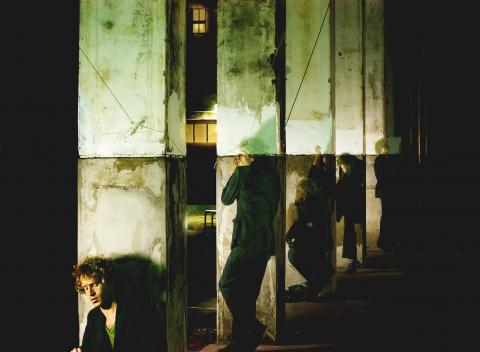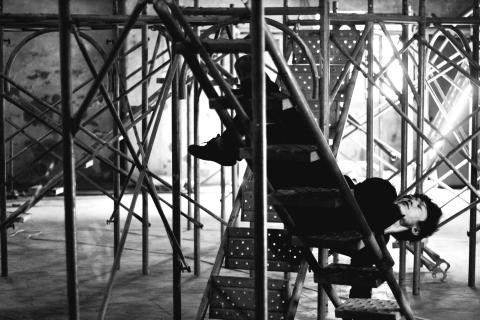Dance collective Horse (驫舞劇場) is taking its biggest jump over the hurdles ever, with an ambitious three-week-long sound environment installation and dance project at Huashan 1914 Creative Park, titled Successor (繼承者).
Starting on Thursday, the troupe will perform a total of 12 shows spread out over three weekends, with each weekend featuring a very different program that includes specific challenges for both dancers and audience members. The second and third weekends build on elements of the first, but while Horse would love people to see a show from each weekend, the programs are also designed to stand alone.
Horse has once again enlisted Taiwan-based French sound artist Yannick Dauby to create the soundscape for the shows. Dauby recruited two old friends and collaborators from France to help out this year, Christophe Havard and Hughes Germain, along with team members from Volume-Collectif.

Photo Courtesy of Horse
The first challenge was to take a 500m2 hall and turn it into a very personal, intimate space for dance, yet one that reflects the building’s unique character and history. The second challenge was to come up with a show that engaged three of the four senses: sight, sound and touch, which meant creating free-standing structures that could both produce and amplify sound.
Horse co-founder and artistic director Chen Wu-kang (陳武康) said they must have been crazy to think they could pull something like this off — and not lose their shirts in the process. They got a grant to help produce the show, but it was NT$500,000 less than they had asked for, he said.
This forced them to be more innovative in terms of staging — for example, seats have been built out of stacks of newspapers sourced from Buddhist Compassion Relief Tzu Chi Foundation recycling centers.

Photo Courtesy of Horse
In addition to Chen, the other dancers/choreographers are troupe co-founders Su Wei-chia (蘇威嘉) and Chou Shu-yi (周書毅) — who now has a fast-growing company of his own — and newcomers (to Horse) Mauro Sacchi from Italy, former Batsheva dancer Shai Tamir, Chou Chun-peng (周浚鵬), Liu Guan-hsiang (劉冠詳) and Huang Yong-huai (黃詠淮).
Show number one, which premieres on Thursday, will see audience members enter the hall into a mini-maze of specially created steel and wooden objects, all of which were built to resonate with their own unique sounds. The audience will have to travel through the maze to find the dancers. Once the show begins, the dancers will split up and move to different parts of the hall to perform on their own — and members of the audience will have to decide who to follow. The audience will be free to move around to watch dancers, but there will be no “one version” of the show. Audience members’ experiences will be based on which dancer(s) they follow and what sounds they hear. Another twist is that not all of the dancers will be performing in each of the shows.
The second weekend’s shows will be more stationary, at least for the audience (which is where all those newspapers come in), though the dancers will still be using various parts of the hall as stages.
The third weekend will be more of a traditional dance performance, with the full troupe dancing together, Chen said.
More than ever, sound is key to the show. Dauby may be the only person ever to move to Taiwan because he fell in love with the sound of the island’s crickets (and frogs, though that is another story). He said the almost industrial sound of male crickets in full cry fascinated him on his first trip to Taiwan; they were not like anything he had ever heard in France or elsewhere in Europe. Over the years of working first with Chou in collaborations for the Taipei Artist Village, and then with Horse, Dauby has created sound environments that mix the sounds of nature — insects, rivers, rain — with urban noise — traffic, industry, buildings, etc — and fragments of music.
He doesn’t like to make the sounds too identifiable, he said, because then the listeners impose their preconceptions on what they are hearing and seeing.
The Huashan shows build on a project he did with friends back in his home region of Brittany, where they projected sound into and through the walls of an old building. People were free to enter the building and wander around and by their movement change the soundscape they heard.
Dauby said he wanted to try to do the same thing here, only because of the age and condition of the Huashan buildings his Volume-Collectif team decided they couldn’t risk turning the walls into amplifiers for fear they might collapse.
Dauby and his team will be “performing” right along with the Horse members, changing and tweaking the sounds and vibrations in response to the dancers and the audiences’ moves and the installation pieces, creating a dialogue of sound.
The Volume-Collectif will also have a chance to shine on their own with a sound installation show in the hall from 10am to 5pm each day there is a performance. Those soundscapes, however, have been pre-recorded.

That US assistance was a model for Taiwan’s spectacular development success was early recognized by policymakers and analysts. In a report to the US Congress for the fiscal year 1962, former President John F. Kennedy noted Taiwan’s “rapid economic growth,” was “producing a substantial net gain in living.” Kennedy had a stake in Taiwan’s achievements and the US’ official development assistance (ODA) in general: In September 1961, his entreaty to make the 1960s a “decade of development,” and an accompanying proposal for dedicated legislation to this end, had been formalized by congressional passage of the Foreign Assistance Act. Two

Despite the intense sunshine, we were hardly breaking a sweat as we cruised along the flat, dedicated bike lane, well protected from the heat by a canopy of trees. The electric assist on the bikes likely made a difference, too. Far removed from the bustle and noise of the Taichung traffic, we admired the serene rural scenery, making our way over rivers, alongside rice paddies and through pear orchards. Our route for the day covered two bike paths that connect in Fengyuan District (豐原) and are best done together. The Hou-Feng Bike Path (后豐鐵馬道) runs southward from Houli District (后里) while the

March 31 to April 6 On May 13, 1950, National Taiwan University Hospital otolaryngologist Su You-peng (蘇友鵬) was summoned to the director’s office. He thought someone had complained about him practicing the violin at night, but when he entered the room, he knew something was terribly wrong. He saw several burly men who appeared to be government secret agents, and three other resident doctors: internist Hsu Chiang (許強), dermatologist Hu Pao-chen (胡寶珍) and ophthalmologist Hu Hsin-lin (胡鑫麟). They were handcuffed, herded onto two jeeps and taken to the Secrecy Bureau (保密局) for questioning. Su was still in his doctor’s robes at

Mirror mirror on the wall, what’s the fairest Disney live-action remake of them all? Wait, mirror. Hold on a second. Maybe choosing from the likes of Alice in Wonderland (2010), Mulan (2020) and The Lion King (2019) isn’t such a good idea. Mirror, on second thought, what’s on Netflix? Even the most devoted fans would have to acknowledge that these have not been the most illustrious illustrations of Disney magic. At their best (Pete’s Dragon? Cinderella?) they breathe life into old classics that could use a little updating. At their worst, well, blue Will Smith. Given the rapacious rate of remakes in modern